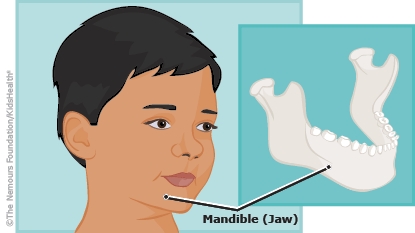After Mandibular Fracture Repair: How to Care for Your Child
It takes time for children to get used to having their teeth held together after their mandibular (jaw) fracture is repaired. Once the break is stabilized and kids adjust to the rubber bands, the discomfort improves within a few days.


Mandibular (jaw) fractures are a fairly common type of facial fracture. A broken jaw affects the moveable lower jaw, called the mandible.
Your child's surgeon repaired the jaw fracture by lining up the pieces of bone. To heal properly, the bone fragments must be held together to prevent them from moving. Sometimes they're held together with plates and screws placed in the bone. Other times, they're kept in place by holding the upper and lower jaws closed with wires or elastics (small rubber bands) placed on the teeth. This is called "intermaxillary fixation" (IMF) or "maxillo-mandibular fixation" (MMF). IMF or MMF is usually left in place for 2–8 weeks to allow the jawbone to heal.

-
Give your child only these types of food during the entire 6-week healing period: soup, liquid nutritional supplements, and foods prepared in a blender. Add protein powder to smoothies.
-
Do not allow your child to play contact sports for at least 6 weeks.
-
Give your child pain medication as directed by your health care provider.
-
Make sure your child rinses his or her mouth twice a day with a germicidal mouth rinse and rinses with water after meals.
-
Your child may return to school when he or she feels better, is taking in enough nutrition, and no longer requires prescription pain medication.
-
Make sure your child keeps the elastics in place until the next follow-up appointment.

-
All or most of the elastics have come off.
-
Your child has swelling or discharge from the gums.
-
Your child's pain becomes severe or isn't relieved by pain medication.
-
Your child has side effects from the pain medication, such as excessive sleepiness, ongoing nausea, or constipation.
-
Your child is vomiting and can't keep down food or fluids.
-
Your child's mouth begins bleeding and doesn't stop.
-
Your child develops a fever above 101°F.

Your child:
-
Appears dehydrated; signs include dizziness, drowsiness, a dry or sticky mouth, sunken eyes, producing less urine or darker than usual urine, crying with little or no tears.
-
Has difficulty breathing.
-
Develops noisy or irregular breathing.

-
Keep scissors or wire cutters with you at all times in case your child has to vomit and you need to remove elastics in a hurry.
-
When the jaw heals, encourage your child to wear a mouthguard when playing sports.